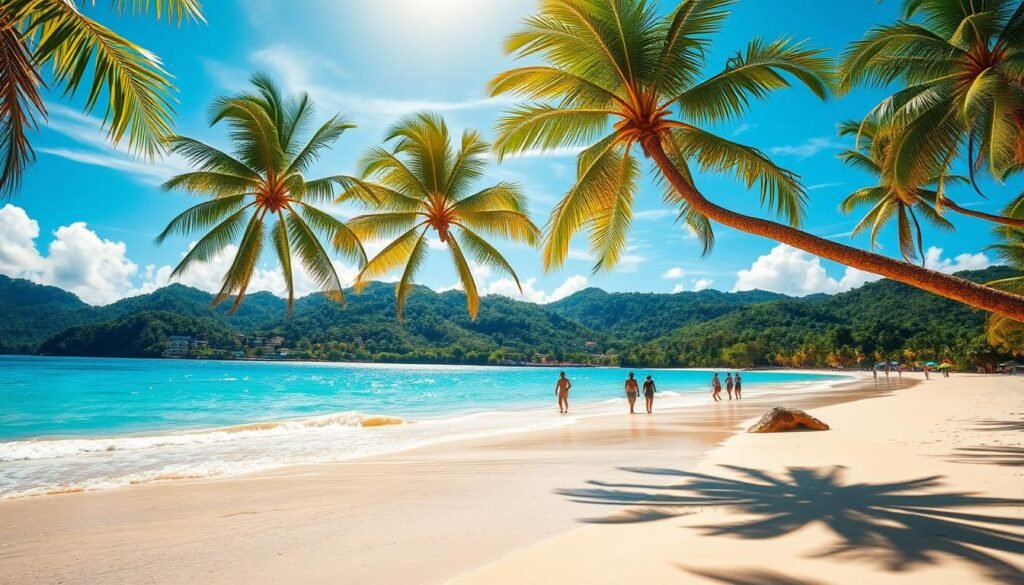Nearly 81°F is the average sea temperature year-round — a fact that surprised me and shaped how I plan trips. That steady warmth means I can swim and snorkel on almost any day, so my choices come down to weather, crowds, and budget.
I narrow my ideal travel window by balancing drier months, lower prices, and the kind of vacation I want. Mid-December to mid-April is the classic high season with cooler, clearer days. July through October runs hotter and sees more afternoon showers and the hurricane peak from August to October.
I also look at regions: the north coast gets more rain thanks to trade winds and the Blue Mountains, while the south is often drier. Shoulder months — mid-April to June and November to mid-December — give me better deals and fewer crowds if I book early.
My plan includes flexible bookings and travel insurance during hurricane season, and choosing Montego Bay or Ocho Rios for lively beaches or Kingston for culture when I want city life.
Key Takeaways
- Sea temps hover around the low 80s°F year-round, so water activities work most months.
- High season: mid-December to mid-April for cooler, drier weather and clearer seas.
- Shoulder months offer better prices and smaller crowds if I book in advance.
- Hurricane season runs June–November; risk peaks Aug–Oct, so I use flexible plans.
- North coast is wetter; south is drier — choose base by the vibe I want.
How I Decide the Best Time to Visit Based on Weather, Crowds, and Prices
Weather is my first filter: it decides which activities will work on any given day. I pick a season by weighing likely skies, heat, and the kind of vacation I want.
I favor the high season for clearer days and cooler nights, but I know prices and crowds spike then. Shoulder months often hit the sweet spot for value and calm. Off-season trips can net big deals, though afternoons get hotter and showers are more common.things-to-do-in-lake-george/
Practical checks guide my choices:
- I watch forecasts and local microclimates — the north coast sees more rain thanks to trade winds.
- I avoid big cruise days at main ports or plan excursions around them.
- I lock in major tours and oceanfront rooms at least three months ahead for peak dates.
- During hurricane season I seek refundable rates and travel insurance for flexibility.
In the end, I name one top priority — prices, weather, or fewer crowds — and accept sensible trade-offs. That keeps planning low-stress and my days sunny more often than not.
Jamaica’s Climate at a Glance: Dry Season, Wet Season, and Trade Winds
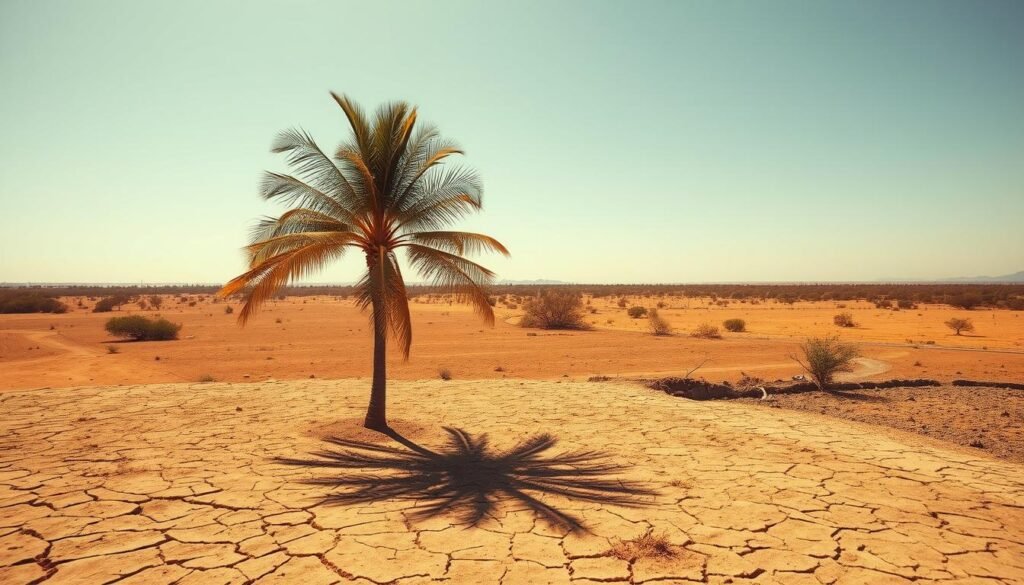
I start by scanning the island’s yearly rhythm so I know how weather patterns will shape my plans. Two clear seasons define most choices: a dry stretch of sunnier days and a wet stretch with more intense afternoon storms.things-to-do-in-okc/
Dry season basics: sunnier days, fewer rainy afternoons
The dry season brings warm, breezy days and often only 2–5 rainy days per month. Winter months can deliver about eight hours of sunshine daily, which I use for hikes and long beach days.
Wet season rhythms: short, intense showers and thundercloud build-ups
The wet run from July through October has heavier afternoon showers and thunderstorms that peak in August–October. These downpours are usually brief and often clear to blue skies later the same day.
Trade winds and mountains: why the north and south coasts differ
I watch how trade winds funnel moisture toward the north coast while the Blue Mountains cast a rain shadow over the south. Kingston averages roughly 31–32 inches of rainfall a year, while Negril can reach about 62 inches.
| Season | Typical months | What I expect |
|---|---|---|
| Dry | Dec–Apr | More sunshine, cooler nights, ideal outdoor days |
| Wet | Jul–Oct | Short heavy showers, higher humidity, lush scenery |
| Shoulder | Apr–Jun, Nov | Balanced weather and fewer crowds |
I rely on averages rather than guarantees, build morning windows into each day, and keep a light rain jacket handy even in dry months so I’m ready for sudden shifts. That strategy helps me pick the best time for the trip I want.
Hurricane Season in Jamaica: What I Watch For Between June and November
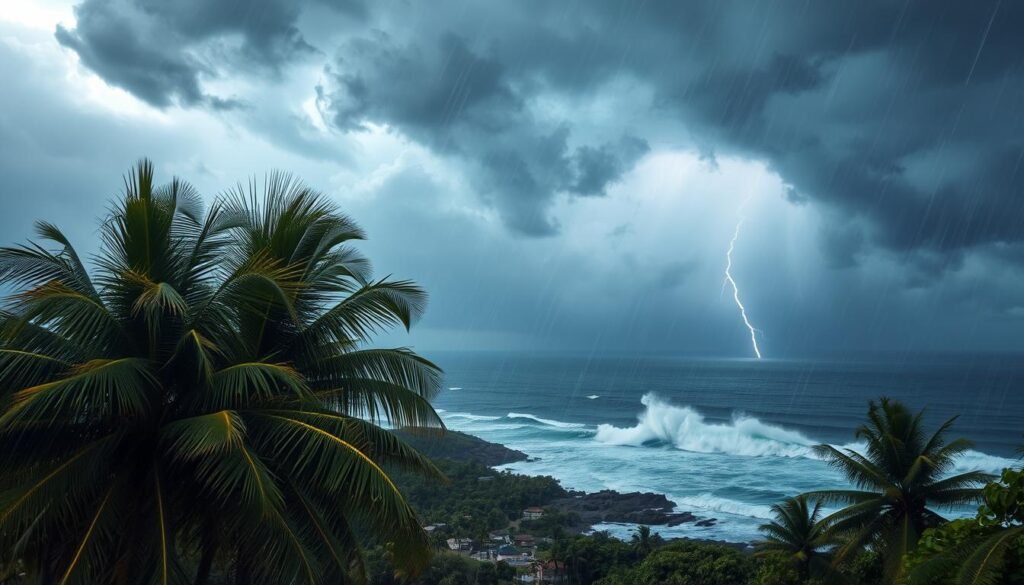
I treat the June–November stretch as a period where weather needs extra attention. I know the peak risk is usually August through October, but showers often clear the same day and full-day downpours are uncommon.
Risk window and historical context
I mark June to November on my calendar and stay most alert in the August–October peak. Historically, Jamaica has seen only six major hurricanes since 1950, so I respect the risk without letting it cancel every plan.
Smart planning: flexible bookings and travel insurance
I track National Hurricane Center advisories in the days before I fly and watch projected paths closely. That helps me decide whether to tweak dates or adjust daily plans.
- I book refundable flights and flexible hotel rates so I can move my trip by a day or two.
- I carry comprehensive travel insurance that covers weather interruptions and extra hotel nights.
- I schedule outdoor activities for mornings and pack waterproof phone protection and quick-dry clothes.
“Lower prices and lighter crowds can make this season a relaxed chance to enjoy the island between storms.”
Peak, Shoulder, and Low Season: What Each Time of Year Feels Like
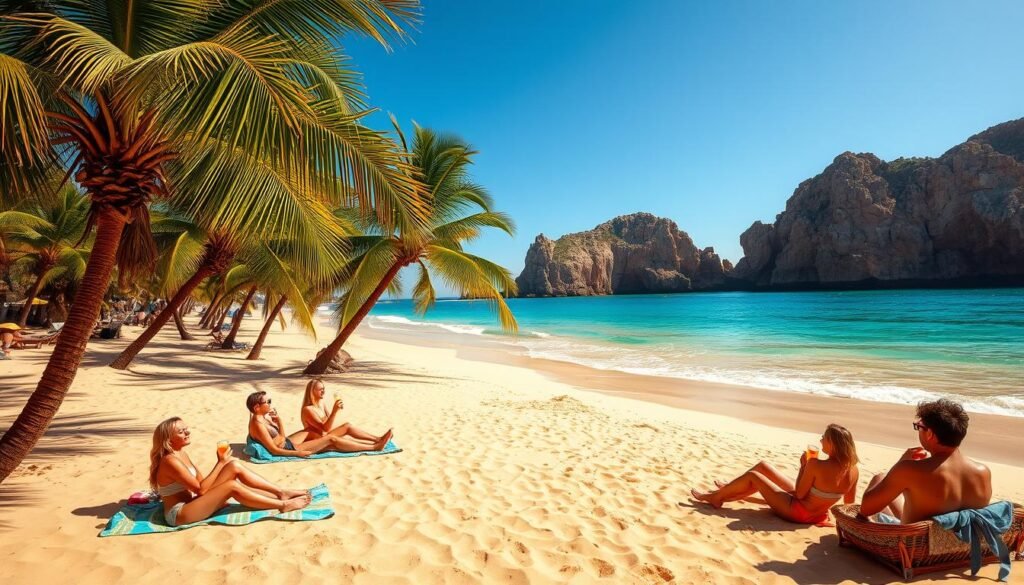
I sort my trip choices by how each season feels on the ground — crisp and bustling or slow and humid. That mood-driven approach helps me choose dates that match the kind of vacation I want.
Peak season (mid-December to mid-April)
Peak months bring cool mornings, bright sunshine, and clearer seas. I expect lively beaches and higher crowds, so I lock major tours, restaurant reservations, and room categories at least three months out.things-to-do-in-madrid-spain/
Shoulder months (mid-April to June, November to mid-December)
The shoulder season is my sweet spot: long sunshine windows, fewer tourists, and gentler prices. Late April through May and early December feel mellow and sun-kissed, with solid availability.
Low/off-season (July to October)
Low season heats up with higher humidity and brief rain bursts; July is often the hottest and October typically sees the most rainfall. I embrace this window for roomy pools and sharp deals, but I build indoor backups like food tours and spa time.
“If you want to compare months and plan ahead, check lead times and flexible rates — I use guides like best time year when tallying options.”
In the end, I pick a season based on mood: festival energy in peak, relaxed balance in shoulder, or restorative savings in the low part of the year when I visit jamaica for a quieter pace.
Regional Weather Differences: Montego Bay, Negril, Ocho Rios, and Kingston
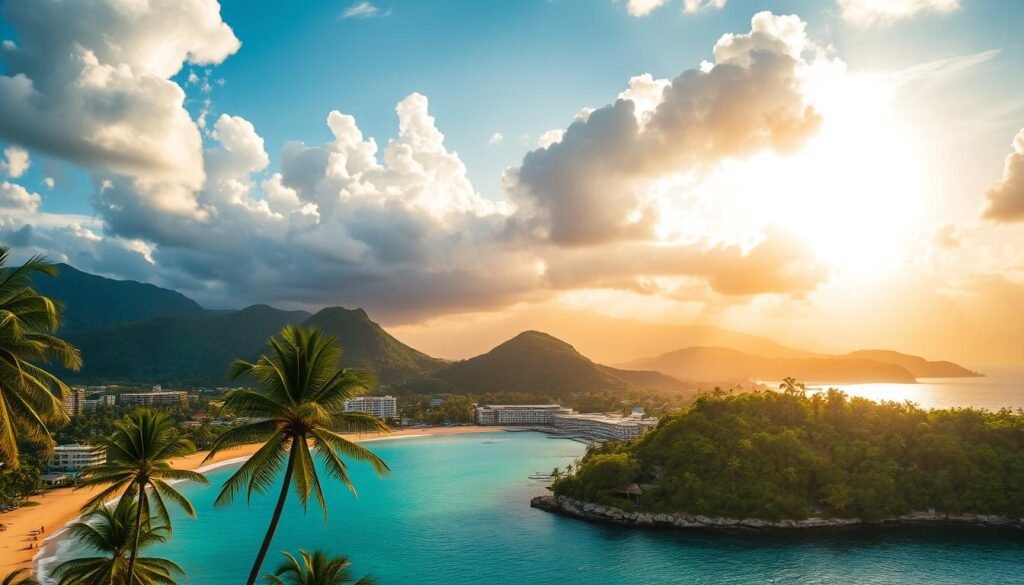
I map climate zones on the island and match them to the kind of days I want. That helps me pick a base for activities, not just a hotel. I watch local weather patterns and plan mornings for heat or showers.
Montego Bay
Montego Bay stays warm year-round. Summers top out in the upper 80s to low 90s°F in July and August. I use MoBay when I want easy airport access, lively beaches, and a classic beach-and-excursions rhythm.
Negril
Negril is sun-soaked and famous for Seven Mile Beach. It also records higher annual rainfall, with October often the wettest month. I book Negril in winter or spring if I want long beach days and dramatic sunsets.things-to-do-in-munich/
Ocho Rios
Ocho Rios is an adventure hub. Warm all year, it sees rain peaks in September–October. I plan waterfalls and river trips for mornings and keep afternoons flexible during that season.
Kingston and the south
The south, including Kingston, is drier thanks to the Blue Mountains’ shelter. City heat can feel strong, but rain is less frequent. I split stays when I want culture and clearer afternoons on the coast.
“I pair regions with plans: MoBay for beaches, Negril for sunsets, Ocho Rios for adventures, and Kingston for culture.”
Quick tip: compare regional rainfall averages with your priorities and pick the season and time of day that match your plans. That helps me find the best time and place to visit jamaica without surprises.
Monthly Guide: The Best Time to Go Month by Month
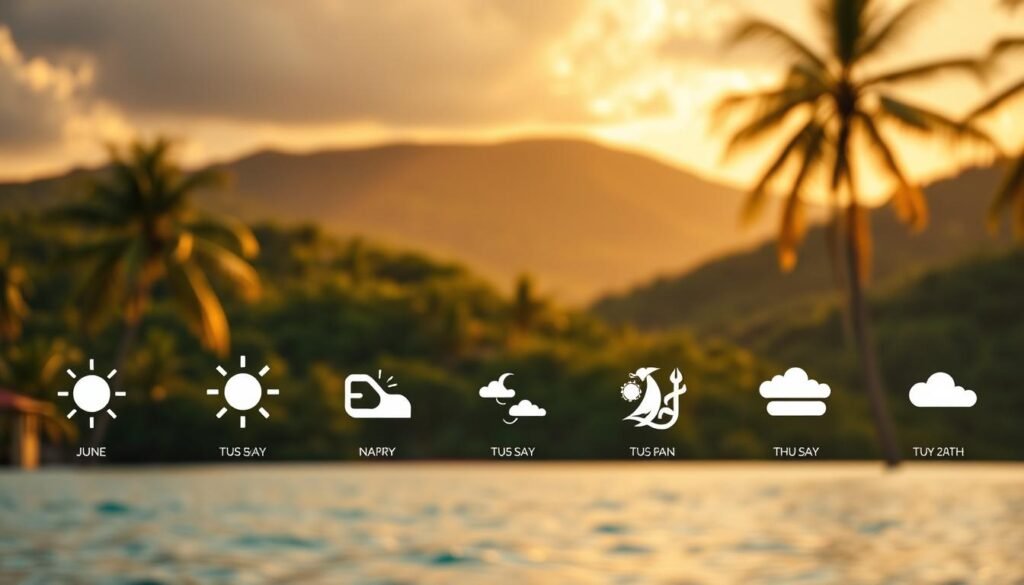
I map my trip by month so I can match festivals, sunshine, and quieter beaches with my mood. Below I summarize how each block of months feels and what I pack into my days.
December to February: winter sun, festivals, and crisp nights in the hills
Why I go: Cooler mornings, big events, and stable water make this a lively window. Early December gives lower prices before mid-month crowds.
March to May: spring vibes and long sunny days
March brings consistently dry days and warm seas. Late April–May is shoulder season, with more sunshine and some brief rain in May.things-to-do-in-naples/
June to August: hot, humid, and lively with summer events
June starts hurricane season; I book morning tours before heat and afternoon showers. July is the hottest, with long sunshine hours. August delivers festivals and national pride.
September to November: hurricane peak into a sweet shoulder
September–October are quieter with great deals but higher rainfall and hurricane risk. November eases into more sun and friendlier fares for the year ahead.
| Months | What I expect | Why I pick them |
|---|---|---|
| Dec–Feb | Cooler nights, big events, calm water | Festivals, Montego Bay access, crisp hill air |
| Mar–May | Long sunshine, warm seas | Ocho Rios adventures, shoulder savings |
| Jun–Aug | Hot, humid, afternoon showers | Summer events, family travel, morning tours |
| Sep–Nov | Quiet beaches, variable rain | Best prices, fewer crowds, green season |
“I keep average sea temps in mind—low 80s°F—so water activities work year-round.”
Bottom line: For a clear pick of the best time visit jamaica I weigh festivals, prices, and weather. That helps me choose the right month and the right vibe every trip.
Sea Temperatures and Water Clarity: When I Swim, Snorkel, and Dive
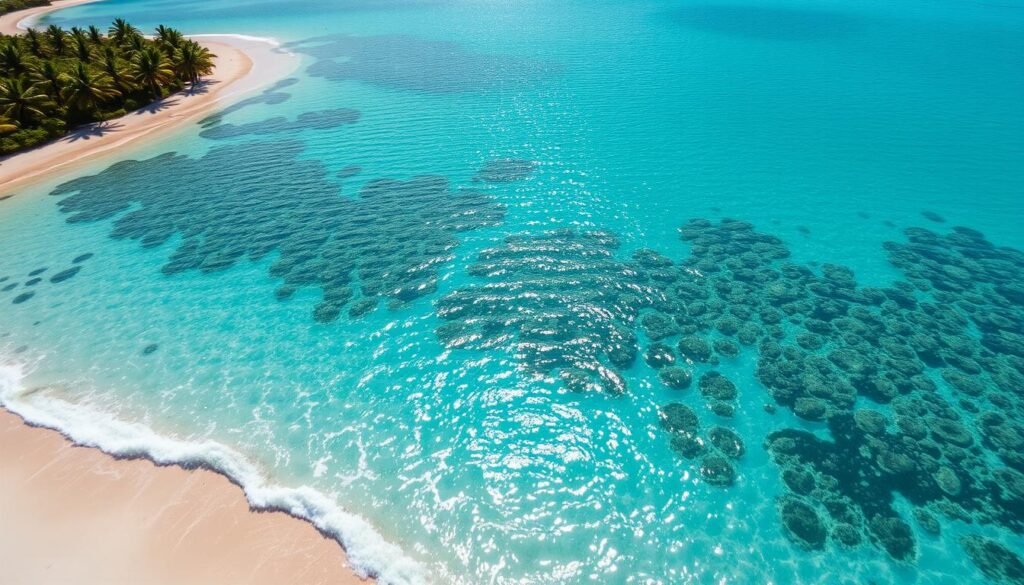
Sea temperature and visibility guide which mornings I book for snorkeling or diving. I rely on steady warmth so I can plan water days with confidence.
Average water temps across the year
Average sea temps run around 82°F. I see about 81°F in January–April and closer to 84°F from July–November.
This means I can swim, snorkel, and dive comfortably in nearly any season without layering up.
Visibility tips: mornings and drier months
Clarity matters more than raw warmth. Winter and early spring tend to deliver calmer seas and less runoff, so underwater visibility often peaks then.things-to-do-in-bend-oregon/
When it’s wetter, I book early morning departures. Winds and afternoon showers stir sediments and drop sightlines.
- Plan mornings: dive boats usually leave early and visibility is better before winds pick up.
- Slide snorkeling into sunny windows and keep a pool or spa backup if a squall rolls through.
- Pack smart: a rash guard for long swims, a dry bag for gear, and good hydration in summer humidity.
“I book dives for early light and check local conditions; for deeper reading on diving seasons I use resources like this dive guide.”
Festivals and Events: Planning a Trip Around Culture and Music
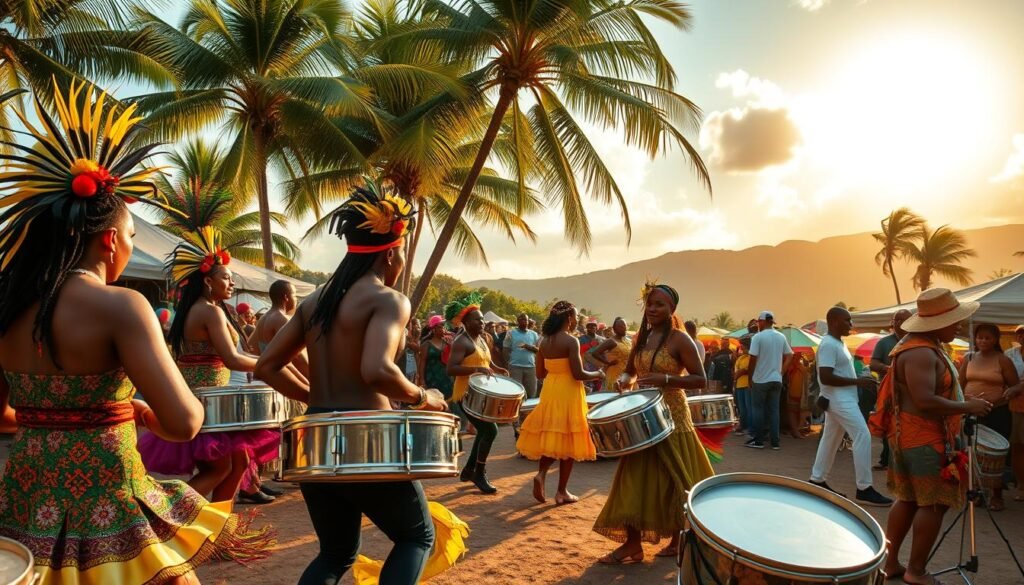
I use headline events as anchors for my itinerary so each day balances music, food, and beach time. Festivals shape the island’s energy and help me pick months that match my mood.
Winter headliners
I time winter trips for Rebel Salute in January and Bob Marley Week in early February. Jamaica Jazz & Blues and the rum festival fall in late winter.
These weeks are culture-rich, so I book concerts and museum visits early.
Spring into summer
Carnival runs from late winter into spring, then Ocho Rios Jazz and coffee festivals warm the months. Mid-July brings Reggae Sumfest in Montego Bay.
I pair daytime beach hours with evening sets for balance.
Fall flavors
Autumn highlights include the Montego Bay Jerk Festival and Port Royal Seafood in October. The Jamaica Food & Drink Festival builds into holiday markets in December.
“I use events as a simple way to plan mornings for calm activities and nights for lively shows.”
| Festival | Typical months | Location | What I expect |
|---|---|---|---|
| Rebel Salute | January | St. Ann | Roots music, relaxed vibe |
| Bob Marley Week | Early February | Kingston | Cultural tributes, concerts |
| Reggae Sumfest | Mid-July | Montego Bay | Late-night shows, big crowds |
| Ocho Rios Jazz | June | Ocho Rios | Jazz sets, seaside concerts |
best time to visit jamaica for Your Style of Trip
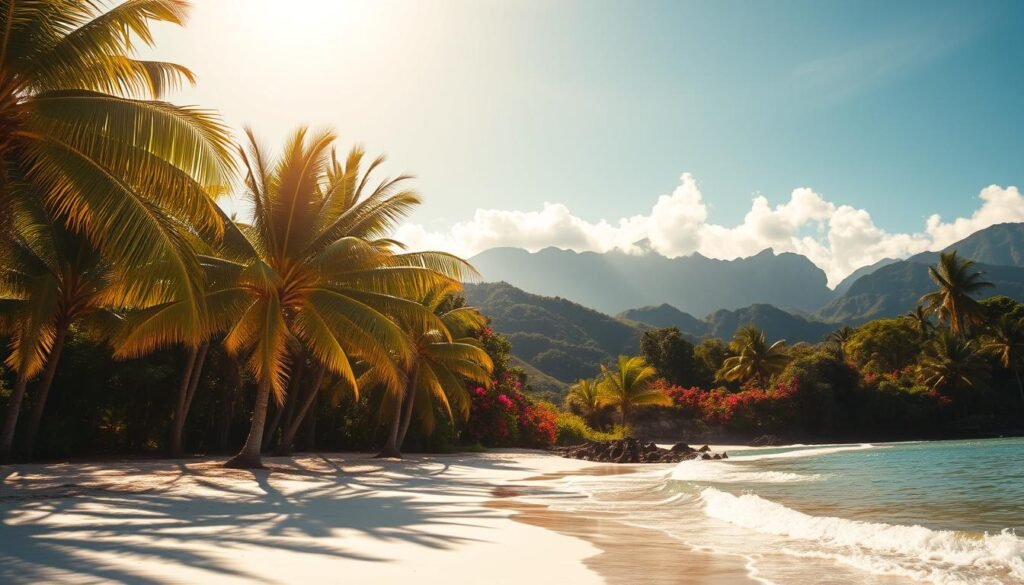
I match each itinerary to the kind of days I want—long sun-soaked mornings or cool mountain dawns. That choice narrows the season and the pace of every trip.things-to-do-in-edinburgh/
Beach and sunshine seekers
I point beach lovers to January–March for breezy, dry days and golden afternoons on the sand. Those months give the most reliable sunshine and calm water for lounging.
Divers and snorkelers
Diving works year-round, but winter often brings the clearest visibility. June–September adds warmer water; I book morning departures for the best clarity.
Surfers and adventure travelers
Surf swells look best in Dec–Mar and again in June–Sept. I watch local forecasts and plan flexible days around prime breaks and guided adventures.
Honeymoons and romantic getaways
For romance I favor Dec–Mar or April–May. Those windows pair comfortable weather with quieter evenings and easier reservations.
Budget-friendly escapes and deal hunters
July–October offers the biggest savings. I advise flexible bookings and travel insurance when I chase lower rates.
Hikers heading for the Blue Mountains
December–April gives drier trails and crisp summit mornings—ideal for sunrise treks and clear vistas.
| Style | Top months | Why I pick them |
|---|---|---|
| Beach & sunshine | Jan–Mar | Dry, breezy, calm water |
| Snorkel & dive | Year-round (peak clarity in winter) | Warm water, best mornings |
| Surf & adventure | Dec–Mar, Jun–Sep | Steady swells and wind-driven breaks |
| Budget stays | Jul–Oct | Lower prices, flexible plans |
Beating the Crowds: Cruise Days, Ports, and Timing Tricks
Port calendars are a travel hack I use to dodge crowds and find quiet hours. I check arrival days for Falmouth, Montego Bay, and Ocho Rios before I lock any plans.
Early starts are my default — waterfalls and coastal walks feel almost private at opening. When ports swell in peak season I shift to late afternoons or to lesser-known coves.
Practical moves that save time and headache
- I steer clear of heavy-call days and aim for off-port mornings to enjoy fewer crowds.
- I reserve high-demand tours 3+ months out in peak weeks so I get first departures.
- Private guides and back roads help me avoid the busiest streets and find quiet viewpoints.
- I split a week between a north-coast base and a night in Kingston to cut repeat port traffic.
“Checking ship schedules and local advice turned a crowded market into a calm, memorable afternoon.”
I pack patience, build transfer buffers on cruise-heavy days, and use locals’ tips so I can enjoy the island even when many others visit jamaica.
Rainfall Reality Check: Showers, Wettest Months, and What I Pack
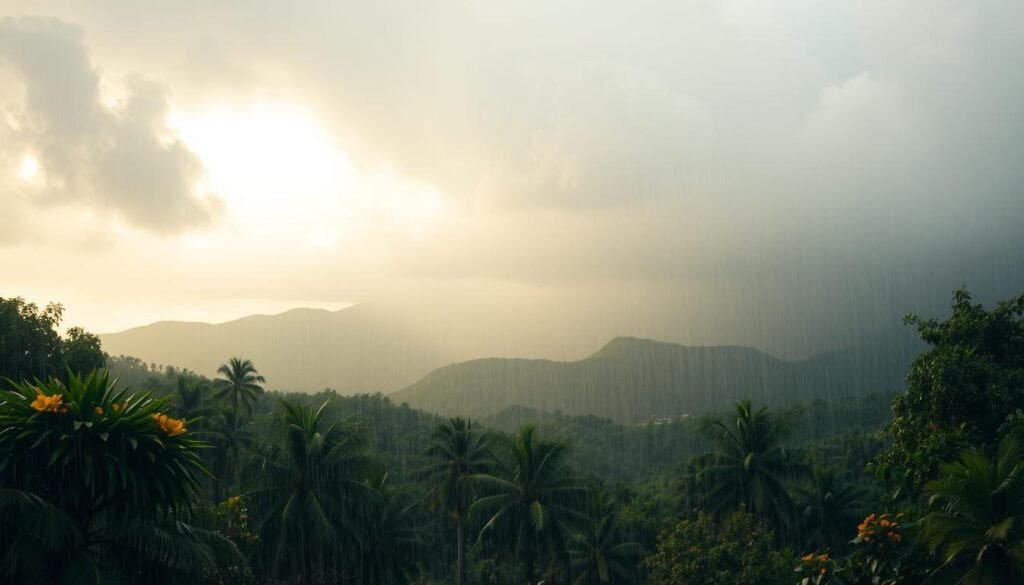
Rain on the island usually comes in quick bursts, so I plan around short wet windows rather than full days of gray.
Understanding local rainfall patterns helps me decide where to stay and how to pack for each season.
North vs. south rainfall patterns
The north coast (think Ocho Rios and Montego Bay) sees more rainfall because trade winds push moisture toward the mountains.
The south, including Kingston, stays drier. The Blue Mountains act as a shield and Kingston averages about 31–32 inches a year.
Month highlights: September–October peaks and dry-season lulls
I mark September and October as the wettest months; October often brings the heaviest downpours.
December through March are among the driest months, so I choose those months for long hikes and full outdoor days.
- I pack a compact rain jacket, quick-dry layers, and a waterproof phone case.
- I set my busiest sightseeing for mornings when showers are less likely.
- I book flexible tickets in September–October so I can slide outdoor plans by a day if needed.
- I pick hotels with covered outdoor areas and plan indoor backups like museums or rum tastings.
“Short showers mean greener hills and fuller waterfalls — rain can be the highlight of the trip.”
Quick practical note: I accept that a sudden shower rarely ruins a full day. Instead, I use cafés and spas as pleasant intermissions and enjoy the dramatic skies that rain brings when I visit jamaica.
Price and Booking Strategy: Flights, Resorts, and Shoulder-Season Deals
I pick a target season, then let fare alerts and resort promos tell me when to book. I set alerts 3–6 months out and move fast when a price dip lines up with my dates.
I watch three windows: early December for value before holiday spikes, shoulder months (mid-Apr–June and Nov–mid-Dec) for lower prices and good weather, and the off-season for deep resort deals—while verifying maintenance schedules.
Flexibility matters: I buy refundable flights or free-change fares during hurricane season and choose refundable resort rates when possible. That keeps my plans nimble without losing access to strong deals.
- I lock oceanfront rooms early for peak weeks, especially in Montego Bay.
- I compare bundled shoulder-season packages that include transfers and activities.
- I align deposit deadlines with my comfort level and check upgrade costs—sometimes club rooms become affordable in shoulder offers.
“I price-watch flights, confirm resort maintenance, and use refundable policies to lock great deals without worry.”
| Window | Why I pick it | Booking tips |
|---|---|---|
| Early Dec | Good weather with lower pre-holiday rates | Set alerts, book 3+ months ahead |
| Shoulder (Apr–Jun, Nov) | Lower prices, solid sun | Check package deals, compare upgrades |
| Off-season (Jul–Oct) | Big resort & flight discounts | Verify maintenance, use refundable rates |
| Peak (Mid-Dec–Mid-Apr) | Highest demand, premium choices | Book 3+ months early, lock oceanfront rooms |
Conclusion
Best time choices come down to what I want from a trip: festivals and dry skies in winter, or space and savings in shoulder months.
November to mid-December is my sweet spot for clearer skies, calmer beaches, and better value before the holiday rush. Late April through May gives warm, sunny days with fewer crowds—great for a short, restorative vacation.
I still nod to peak months for marquee events and cool evenings, and I treat hurricane season with sensible flexibility. Sea temps sit in the low 80s°F year-round, so swimming and snorkeling nearly always work.
Plan around your interests—music, food, hiking, or culture—book early for peak weeks, use refundable options in riskier months, and check cruise schedules. Small timing choices—early mornings and sunset stops—turn a good trip into a truly memorable one.


